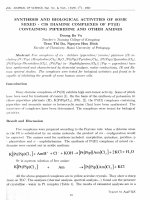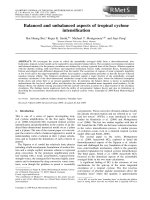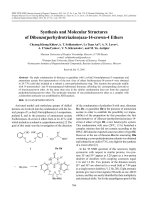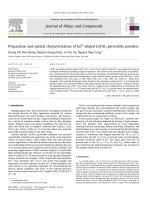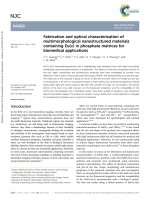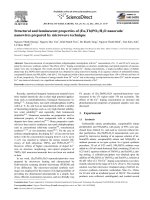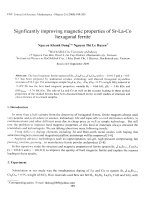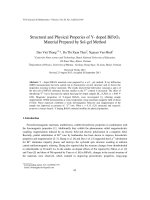DSpace at VNU: Structure and electrical properties of the spin 1 2 one-dimensional antiferromagnet Ca2CuO3 prepared by the sol-gel technique
Bạn đang xem bản rút gọn của tài liệu. Xem và tải ngay bản đầy đủ của tài liệu tại đây (475.77 KB, 9 trang )
Home
Search
Collections
Journals
About
Contact us
My IOPscience
Structure and electrical properties of the spin 1/2 one-dimensional antiferromagnet Ca2CuO3
prepared by the sol–gel technique
This content has been downloaded from IOPscience. Please scroll down to see the full text.
2007 J. Phys.: Condens. Matter 19 106215
( />View the table of contents for this issue, or go to the journal homepage for more
Download details:
IP Address: 128.192.114.19
This content was downloaded on 03/09/2015 at 07:17
Please note that terms and conditions apply.
IOP PUBLISHING
JOURNAL OF PHYSICS: CONDENSED MATTER
J. Phys.: Condens. Matter 19 (2007) 106215 (8pp)
doi:10.1088/0953-8984/19/10/106215
Structure and electrical properties of the spin 1/2
one-dimensional antiferromagnet Ca2 CuO3 prepared
by the sol–gel technique
Dang-Chinh Huynh1 , Duc-The Ngo2 and Nam-Nhat Hoang3,4
1 Faculty of Chemical Technology, Hanoi University of Technology, 1 Dai Co Viet, Hanoi,
Vietnam
2 Department of Physics and Astronomy, University of Glasgow, Glasgow G12 8QQ, UK
3
Centre for Materials Science, College of Science, Vietnam National University Hanoi,
334 Nguyen Trai Road, Hanoi, Vietnam
E-mail:
Received 11 January 2007
Published 23 February 2007
Online at stacks.iop.org/JPhysCM/19/106215
Abstract
Highly homogeneous finely powdered Ca2 CuO3 has been prepared by the sol–
gel technique. No evidence for CaO and CuO impure phases was observed.
The single-phase purity was observably better than that of samples prepared
by the ceramic method and oxalate co-precipitation. On the basis of the
structural parameters determined, the bond valence sum approach was involved
in explaining the weak interchain direct Cu–Cu covalent bonding. The I –V and
ρ(T ) measurements showed constant semiconductor behaviour with resistivity
increase above 108
cm in the low temperature region. The fitting of ρ(T )
using a band gap model gave an activation energy as small as 0.19 eV. This
finding demonstrates well the covalent insulator nature of this system.
1. Introduction
Since the discovery of high Tc superconducting ceramics, the strongly anisotropic, S = 1/2
quasi-1D antiferromagnet Ca2 CuO3 containing infinite anionic CuO3 chains has attracted
continuous attention due to interesting physical issues and structural similarity to sister
superconductors. The observed extremely low ordered moment and reduced N´eel temperature
(≈0.06 μB and 5 K for Sr2 CuO3 ; 0.05(3) μB and 9 K for Ca2 CuO3 [1, 2]) together with a
record value among 1D systems for the intrachain exchange integral J ≈ 0.2 eV (1300 K)
(whereas the interchain coupling is only J⊥ ≈ 0.01 meV) [3, 4] have led several scientists to
consider such compounds as ‘superstars’ in the field of low dimensional magnetism [5]. To
date, Ca2 CuO3 (and its derivatives) has been synthesized mainly via the ceramic route but the
4 Author to whom any correspondence should be addressed.
0953-8984/07/106215+08$30.00 © 2007 IOP Publishing Ltd
Printed in the UK
1
J. Phys.: Condens. Matter 19 (2007) 106215
D-C Huynh et al
achievement of single-phase Ca2 CuO3 was known to be very difficult. According to present
equilibrium phase diagrams for the CaO–CuO pseudo-binary system, the coexistence of phases
Ca2 CuO3 , CaCu2 O3 , CaO and CuO, plus a liquid phase above 1020 ◦ C, can be considered. Dou
et al [6] has reported the preparation of Ca2 CuO3 by the oxalate co-precipitation technique and
showed that the Ca2 CuO3 phase was formed at 800 ◦ C and its proportion increased with the
calcining temperature. But even after calcining at 870 ◦ C for 48 h, a proportion of CuO phase
was still present in the sample as observed in x-ray diffraction patterns (figure 1 in [6]). It
was pointed out that the lattice parameters tend to increase with increasing CuO dissolution.
Later, Wada et al [7] reported the structure of single-crystal Ca2 CuO3 prepared by the travelling
solvent floating zone (TSFZ) method using an excess CuO content of about 10 mol%. This
deviation from the known phase diagrams, leading to impure phases, e.g. CaCu2 O3 (<5%),
was explained by the possible dissociation of CuO into Cu2 O and O2 at high temperature which
results in a deficit of reacting CuO, so requiring the adding of this component. The lattice
parameters from the above two cases agree quite well with the recent report of Zhang et al
˚ (ceramic route). These authors
[8], where a = 3.257(3), b = 3.776(9) and c = 12.23(6) A
showed that under pressure up to 34 GPa, the lattice parameters reduced ≈5% in length and the
resistance dropped from above 104 to nearly 102.7 . Unfortunately, inadequate information on
preparation was given. So to get a single-phase powder of good quality for further preparation
of new materials and study of electronic properties, we have prepared the Ca2 CuO3 by the
sol–gel route.
2. Experimental details
A mixture of Ca(NO3 )2 and Cu(NO3 )2 in the required molar proportion was dissolved in
water and an aqueous solution of citric acid (CA) was added, keeping the CA/metal ion ratio
within 1.6–2.0 according to the pH of the solution. Then with vigorous stirring, the ammonia
solution was added slowly to maintain the pH within 3–3.5. A homogeneous transparent blue
gel appeared after sequential heating up to 80 ◦ C for a while. The blue gel was dried in air
for a day to form a xerogel and calcined at 550 ◦ C for several hours to burn off the organic
compounds. The middle product was sintered at 920 ◦ C for 24 h in open air to produce the final
Ca2 CuO3 powder which was then pressed into cylinders of 10 mm diameter and 1 mm height.
Before calcination (at 550 ◦ C), the xerogel was examined by DTA/TGA analysis (using a TA
SDT 2960 system). For SEM and EDX analysis the Jeol 5410 LV and the Oxford ISIS 300
systems were used. For ρ(T ) measurement (figure 5), the Au contact was sputtered on both
faces of the samples (by Leybold DC/RF Univex 450). For I –V measurement, only one face
was sputtered while the other was attached to an ohmic contact. Besides, a reference sample
was made by the ceramic route using the procedure described in [10] (the sintering temperature
was 870 ◦ C) from the source powder CaCO3 (99.9%; Merck) and CuO (99.99%; MaTeck). The
characteristics of this sample are also included in section 3 for comparison.
3. Results and discussion
Figure 1 shows the DTA and TGA analysis of the xerogel. One exothermal peak appeared at
470 ◦ C and one endothermal peak at 800 ◦ C. The peak at 470 ◦ C with relatively large weight
loss corresponds to the oxidation of organic substances where the peak at 800 ◦ C corresponds to
the forming of Ca2 CuO3 phase which frees the excess O2 . This temperature agrees exactly with
the one reported by Dou et al [6] for forming of Ca2 CuO3 phase by the oxalate co-precipitation
technique. Figure 2 shows the x-ray diffraction patterns of the samples made by ceramic and
2
J. Phys.: Condens. Matter 19 (2007) 106215
D-C Huynh et al
5
TGA
0
-5
25
470
-10
15
-15
DTA
Weight [%]
Heat flow [mW]
35
-20
5
800
-5
-25
-30
0
200
400
600
Temperature [°C]
800
Figure 1. DTA and TGA analysis of the xerogel.
sol–gel routes. The indexing of peaks followed the (−cba ) axis orientation (used in [8]) rather
than the (abc) orientation (used in [10] and in JCPDS Files [20]). In the (−cba ) orientation,
the c axis is the longest axis. These diffractograms were taken on the Bruker D5005 system
and analysed by the Rietveld technique using WinMProf software [21]. The ceramic sample
showed traces for both CaO and CuO phases as indicated by peaks (200), (220) (CaO) and
(110), (111), (200) (CuO). Except (110) (CuO), all these peaks—especially the (200) (CaO)—
also appeared in the diffractogram given by Zhang et al [8] (ceramic route). In comparison to
this, our sample seemed to have the same quality and showed a similar tendency towards having
been enriched by a small proportion of CaO phase. For the ceramic route, the amount of CuO
present in the final product was comparable to the amount of CaO whereas for the oxalate
co-precipitation technique [6], there was no evidence for CaO but the intensity of the peak
pair (111, 200) (CuO)—indicating the presence of a larger amount of CuO—was significantly
stronger. The sol–gel sample showed, on the other hand, only peaks for the Ca2 CuO3 phase, but
with two new ones: (011) and (004). These peaks are weak and were not observed before [6, 8].
It is important to note that they belong strictly to the Ca2 CuO3 phase, not to the impurity. It
was observed that they would be stronger if the Ca were to be substituted by elements with
larger atomic x-ray scattering factors, e.g. by lead or uranium. Doing that, there would appear
three more weak peaks in the diffractogram of Ca2 CuO3 : (112), (211) and (204) (shown by the
down arrows in figure 2) [19]. The higher purity of phase for the sol–gel sample can easily be
checked against the CaO and CuO peaks indicated by vertical bars placed immediately below
the main diffractograms in figure 2. Figure 3(a) shows the EDX analysis for the sol–gel sample;
no elements other than Ca, Cu and O were observed. The Raman scattering measurement
(discussed elsewhere) also showed peaks for Ca2 CuO3 phase only, not for either CaCu2 O3
(ladder compound, Pmmn ) or CuO (C 2/c). The Fourier fitting for the peak shape using WinFit
software [22] showed the average monocrystal size to be 32 nm which is about 20 times smaller
than the average 640 nm for the polycrystalline particle size shown via SEM (figure 3(c)).
For the ceramic sample, the monocrystal size was nearly the same but the particle size was
significantly larger; it lies between 1 and 3 μm (figure 3(b)). The fact that the sol–gel derived
diffractogram (figure 2) does not show peak broadening was probably caused by technological
setting: the higher sintering temperature and longer sintering time were customized for the
sol–gel route.
3
J. Phys.: Condens. Matter 19 (2007) 106215
D-C Huynh et al
Figure 2. X-ray diffraction patterns for Ca2 CuO3 . The hkl indices of the Ca2 CuO3 phase
correspond to the (−cba ) axis orientation. For the ceramic sample, only peaks that do not
correspond to Ca2 CuO3 phase are indexed. For the sol–gel sample, the down arrows show minor
peaks. The vertical bars at the bottom show the main peak positions for CaO and CuO phases with
hkl indices given above each bar.
Figure 4 shows the structure of the Ca2 CuO3 phase as refined in the I mmm space group
(no. 71, D25
onflies notation). The profile refinement was carried out using the pseudo2h in Sch¨
Voigt function and included the scale factors, zero point, background, half-widths, correction
to asymmetry and cell parameters in the first stage. After that the atomic coordinates and
temperature factors were refined. Because of symmetry, only z coordinates of O(1) and Ca
were allowed to vary; all other were fixed. The site occupation factors were also fixed except
for those of the two oxygens. The Ca2 CuO3 lattice differs from that of the La2 CuO4 (2D
system) only by one missing oxygen in the a direction. The CuO4 plaquettes, sharing a
corner oxygen O(2), are connected into infinite chains in the b direction with the Cu–O–Cu
angle equal to 180◦ . Such a 1D arrangement is lacking in both a and c directions. The
˚ versus
CuO4 unit is not square, as the Cu–O bond is elongated in the c direction (1.96 A
˚
˚
1.89 A in the b direction). The interchain separation is 3.25 A, exactly equal to the
a axis one.
4
J. Phys.: Condens. Matter 19 (2007) 106215
D-C Huynh et al
(a)
(b)
(c)
Figure 3. EDX spectrum for Ca2 CuO3 sample (a); the SEM photograph of the surface for a
reference sample made by the ceramic route (b) and for the sol–gel sample (c).
Figure 4. The structure of Ca2 CuO3 from Rietveld analysis of powder data with thermal ellipsoids
drawn by ORTEP [23] (a) and the bonding of atoms within the unit cell (b).
Table 1 gives bond lengths, isotropic thermal motion coefficients (BISO ), estimated
stoichiometry x (site occupation factors). It is worth noting from figure 4 that the anisotropic
thermal motions of Ca atoms show excessive movement along the c axis. This was probably
caused by the existence of only one Ca–O bond along this direction in the coordination pyramid
O(1)–CaO(1)4 which eased the Ca movement vertically. Thus the preferred vibration mode is
the stretching axial motion, giving rise to the strong Raman allowed Ag mode phonons observed
at 306 cm−1 [9]. The anisotropic thermal motion coefficients obtained from Rietveld refinement
agree well with this observation.
5
J. Phys.: Condens. Matter 19 (2007) 106215
D-C Huynh et al
Figure 5. The thermal dependences of the resistivity for Ca2 CuO3 . Circles denote the sol–gel
sample whereas triangles denote the ceramic one. The straight lines were fitted according to the
band gap model. The p–n junction’s I – V characteristic for the sol–gel sample at 300 K is featured
in the inset.
Table 1. The structural parameters for Ca2 CuO3 . The standard deviations are given in parentheses.
(Least square R -factors: RF (intensity) = 4.2, RP (profile) = 9.3, RWP (weighted profile) = 10.4,
˚ V = 150.4(5) A
˚ 3 .)
S.G. = I mmm , a = 3.254(2), b = 3.778(5), c = 12.235(1) A,
Atom
˚ 2)
BISO (A
x
Bond
˚
Length (A)
Ca
Cu
O(1)
O(2)
0.23(2)
0.16(1)
0.49(5)
0.51(8)
2
1
0.98(2)
1.0(3)
Cu–O(1)
Cu–O(2)
Cu · · · Cu
Cu–O(2)–Cu
1.958(4)
1.889(1)
3.254(2)
3.778(5)
The high purity of the phase of the sol–gel sample allowed us to adopt the bond valence
sum model for analysis of the relationship between the structure and electronic properties of
Ca2 CuO3 . Basically there are two models for bond valences: the one derived from a Born–
Land´e type of potential [12] and the one based on minimization of the molecular orbital
stabilization energy [16]. According to the first, the actual distributed valence within a given
bond (e.g. to O) is estimated as exp[(R0 − R)/B], where R is the bond length, R0 and B are
empirical constants. Using the bond lengths from table 1, the actual oxygen bonded valence of
Cu is +2.07, and that of O is −2.01. These values show excellent agreement with the nominal
oxidation state +2/−2 of Cu/O and with +2.09 for Cu reported in [10]. The second model
uses the polynomial estimate ai /R i for bond valences and provided nearly the same result.
So the structural parameters given in table 1 are believed to be correct.
This enables us to provide forecast of the direct interchain interaction between two Cu
atoms. The possibility of Cu ions creating strong covalent bonding to the neighbouring Cu ions
without changing the oxidation state is an interesting aspect of Cu bonding in cuprates. Such
a direct Cu–Cu bond was observed experimentally for Cu2 O using convergent beam electron
diffraction and x-ray charge density mapping by Zuo et al [13]. In Cu2 O the Cu has a full d
shell 3d10 and an unoccupied 4s1 state. It has been shown that there was a hybridization of the
Cu1+ 3d2z2 orbital with the higher unoccupied Cu1+ 4s orbital, which removed 0.22e from 3d2z2
and created an observable d hole. The distributed charge in the tetrahedral interstitial region of
6
J. Phys.: Condens. Matter 19 (2007) 106215
D-C Huynh et al
−3
˚ , suggesting a strongly covalent character of the
four neighbouring Cu atoms was ≈0.2e A
2+
Cu–Cu bonding. In Ca2 CuO3 the Cu ion has the electronic state 3d9 with a half-filled d1x 2 −y 2
band and an empty 4s band. So theoretically there is enough room for relocation of charge from
3d2z2 orbital to the outer 4s. From the structural point of view, this process if it happens must
˚ for Cu2 O instead of
be weaker than in Cu2 O because of the longer Cu–Cu distance (3.02 A
˚ for Ca2 CuO3 ). To be precise, the 0.25 A
˚ longer bond length induces a 50% lower bond
3.25 A
valence, i.e. the shared valence in Cu2+ –Cu2+ is only 0.11e, half of the 0.22e of Cu2 O. The
weaker interchain covalent bonding in Ca2 CuO3 has some support from theoretical calculation
of the magnetic coupling ratio J /J⊥ of the intrachain and interchain couplings (parallel and
perpendicular to axis b ) on the basis of the t – J model which showed J /J⊥ = 321 and the
hopping parameter ratio t /t⊥ = 16 [5, 14].
Figure 5 shows the thermal dependences of the resistivity measured with a sensitive
four-electrode set-up for both sol–gel and ceramic samples. The I –V curve shown in the
inset corresponds to the sample prepared by the sol–gel route and was measured for the p–
n junction composed of a sample and different contacts (Schottky/Ohmic) at its two faces.
The exponential shape of the I –V curves demonstrates the typical semiconductor behaviour of
the sample. From this figure a thermally activated conduction mode can be expected. As the
exponential characteristics remained unchanged on lowering the temperature, the conduction
mode appeared to hold constant. The same was observed for the ceramic sample. Commonly
there are three main approaches for interpreting the ρ(T ) curves obtained: the classical band
gap model (T −1 law), the small polaron model (T −1 law) and the variable range hopping model
(T −1/4 law). For the Ca2 CuO3 , the usual way is to consider the hopping of small polarons
since the observation of localized holes at oxygen sites associated with structural deformation
provides a good supporting argument for it. However, as the fit did not give a satisfactory result
at low temperature, we have tried the classical band gap law. The fitting according to this model
gave thermal activation energy quite close to those values already reported, although the fit still
showed a small deviation at lower temperature. Recently, the regime of percolative conduction
through the grain boundary as the fractal conduction medium seemed to be essential for several
Ru doped manganate and ruthenate perovskite ceramics [15] but due to the insulator character
of Ca2 CuO3 we do not expect it here.
To interpret ρ(T ) within the framework of the band gap model, the measured data were
fitted with the expression ln ρ ∝ E/kB T and the thermal activation energy was determined
from the slope. We obtained E = 0.19 eV for the sol–gel sample and 0.26 eV for the ceramic
one. Both values are far below the 1.70 eV obtained via optical measurement [11] and seem to
correspond to 0.18 eV reported on the basis of transport measurements [17, 18]. The occurrence
of high resistivity in contrast to the relatively small thermal activation energy nicely illustrates
the covalent insulation state in our samples. Unlike in pd metals where the upper Hubbard
band falls within the O 2p orbital due to small intrachain hopping parameter t (= ψ p |H |ψd ),
in covalent insulators such as Ca2 CuO3 the t increases according to the shortening of the
intrachain Cu–O(2) length. Thus the energy separation between the Cu 3d–O 2p bonding state
and the anti-bonding state enlarges. At certain finite t the compound becomes an insulator since
the conduction band has lifted above the half-filled anti-bonding level serving as the insulating
ground state [17]. Although the gap is small, the localization of holes at the oxygen sites is
essential for the state of so-called covalent insulation.
A small increase in activation energy seen for the ceramic sample may be due to the
presence of impurities which induces larger local distortion to Cu–O chain but may also come
from the impure phases themselves. Commonly, the conduction mechanism in this system, and
in ceramics too, is a complex problem, so further studies are needed to shed light on it.
7
J. Phys.: Condens. Matter 19 (2007) 106215
D-C Huynh et al
4. Conclusions
Single-phase, high quality fine powder of the quasi-1D antiferromagnet Ca2 CuO3 has been
successfully synthesized by the sol–gel technique. It was demonstrated by careful structural
analysis that this method has led to a better result than others such as the oxalate co-precipitation
and ceramic routes. The 1D behaviour of Ca2 CuO3 was clearly demonstrated by analysis of
the Cu–Cu direct interaction along the a axis and the Cu–O–Cu coupling along the b axis.
The measurement of the resistivity using a very sensitive four-electrode set-up has shown the
continuous semiconductor behaviour with resistivity increased quickly to above 108 cm in
the low temperature region. The band gap model identified an activation energy as small as
0.19 eV, so with this value our sample manifests itself clearly as a typical covalent insulator.
References
[1] Yamada K, Wada J, Hosoya S, Endoh Y, Noguchi S, Kawamata S and Okuda K 1995 Physica C 253 135
[2] Kojima K M, Fudamoto Y, Larkin M, Luke G M, Merrin J, Nachumi B, Uemura Y J, Motoyama N, Eisaki H,
Uchida S, Yamada K, Endoh Y, Hosoya S, Sternlieb B J and Shirane G 1997 Phys. Rev. Lett. 78 1787
[3] Ami T, Crawford M K, Harlow R L, Wang Z R, Johnston D C, Huang Q and Erwin R W 1995 Phys. Rev. B
51 5994
[4] Motoyama N, Eisaki H and Uchida S 1996 Phys. Rev. Lett. 76 3212
[5] Rosner H, Eschrig H, Hayn R, Drechsler S-L and Malek J 1997 Phys. Rev. B 56 3402
[6] Dou S X, Guo S J, Liu H K and Easterling K E 1989 Supercond. Sci. Technol. 2 308
[7] Wada J, Wakimoto S, Hosoya S, Yamada K and Endoh Y 1995 Physica C 244 193
[8] Zhang G M, Mai W J, Li F Y, Bao Z X, Yu R C, Lu T Q, Liu J and Jin C Q 2003 Phys. Rev. B 67 212102
[9] Yoshida M, Tajima S, Koshizuka N, Tanaka S, Uchida S and Ishibashi S 1991 Phys. Rev. B 44 11997
[10] Lines D R, Weller M T, Currie D B and Ogborne D M 1991 Mater. Res. Bull. 26 323
[11] Maiti K, Sarma D D, Mizokawa T and Fujimori A 1998 Phys. Rev. B 57 1572
[12] Altermatt D and Brown I D 1985 Acta Crystallogr. B 41 244
[13] Zuo J M, Kim M, O’Keeffe M and Spence J C H 1999 Nature 401 49
[14] de Graaf C and Illas F 1999 Phys. Rev. B 63 014404
[15] Hoang N N, Huynh D C and Phan M H 2006 Solid State Commun. 139 456
Thanh P Q, Nhat H N and Chinh H D 2006 J. Magn. Magn. Mater. doi:10.1016/j.jmmm.2006.11.031
[16] Valach F, Hoang N N, Maris T, Saunders A, Cowley A, Watkin D J and Prout C K 2003 Progress in Coordination
and Bioinorganic Chem ed M Meln´ık and A Sirota (Bratislava: STU Press)
Valach F 1999 Polyhedron 18 699
[17] Maiti K and Sarma D D 2002 Phys. Rev. B 65 174517
[18] Shin Y J, Manova E D, Dance J M, Dordor P, Grenier J C, Marquesteut E, Doumere J P, Pouchard M and
Hagenmuller P 1992 Z. Anorg. Allg. Chem. 616 201
[19] Hoang N N and Huynh D C 2007 Structure, Raman and transport properties of the uranium-doped Ca2 CuO3 , at
press
Phung Q T, Hoang N N and Huynh D C 2007 Possible phonon-assisted electron hopping conduction in the
uranium doped Ca2 CuO3 J. Korean Phys. Soc. at press
[20] JCPDS Files No. 34-0282 (Ca2 CuO3 ); no37-1497 (CaO); no5-661 (CuO).
[21] Jouanneaux A 1999 CPD Newslett. 21 13
[22] Krumm S 1994 Acta Universitatis Carolinae Geol. 38 253
[23] Burnett M N and Johnson C K 1996 ORTEP/1/Report ORNL-6895 Oak Ridge National Laboratory, TN, USA
8

